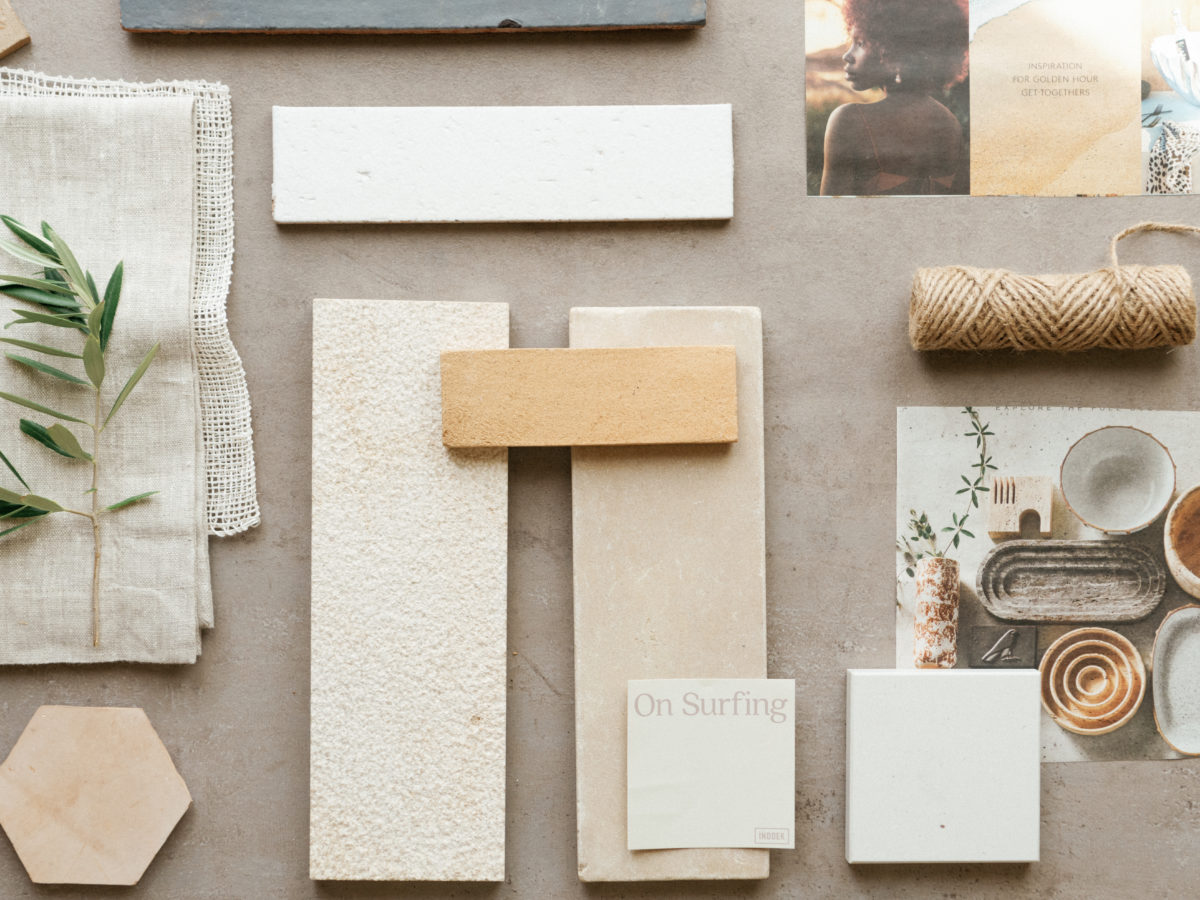
Finishes Can Make or Break a House. Here’s How to Mix and Match Materials
Camille Styles handpicked the material for each surface in her Malibu beach house. Get an inside look at her mood board.

Join guest editor Camille Styles as she and her family transform a 1950s Malibu beach bungalow into their dream retreat—and in the process, discover a slower, more intentional way of living, rooted in the beauty of the West. It’s all part of our journey to the Sunset 2023 Idea House, a home that displays the latest innovations in Western home design.
Imagine the feeling of sinking your feet into a plush wool rug when you climb out of bed in the morning. Is there anything more comforting? It’s a simple moment that grounds me at the start of each day, and a reminder that the textures and materials in our homes go a long way toward creating an experience that sparks joy. If you joined us for the first installment of our series chronicling my Malibu beach house renovation (which will ultimately become the 2023 Sunset Idea House), you’ll remember that the first step in my design process was defining how I want to feel in the finished space. Well, nothing influences feeling quite like the materials around me—combined with color and form, they can evoke deep emotion. Through material, we can enhance our everyday experiences by creating a sense of coziness, calm, a clean slate, or a fresh perspective.
I began by creating a mood board defining the materials and color palette that I want to carry throughout the beach house. Though I have friends who feel energized by choosing a different tile and paint color for every room in the house, I’m always pursuing a feeling of serenity in my own home. For me, that goes hand-in-hand with some level of consistency throughout the spaces. I love to choose a few special touches for certain areas, but in general, it’s the repetition of materials and color throughout the house that gives it a cohesive point of view. For our beach house, we’re using a calming, neutral color palette, so one of the main ways I’ll add interest to the space is through textural materials that introduce contrast: hard against soft, smooth next to rough.

Michelle Nash
There are certain materials I’ve always been drawn to, and they usually come from the earth—stone, wood, linen, and clay. This attraction to natural elements has been my compass as we home in on the materials we’ll be using throughout this project, illuminating the earthy hues that naturally come with them.
As I go through the materials selection process, I’ve been ordering as many samples from potential vendors as possible. I’ve started laying them out, side by side, to see how each element plays against the others. Especially when working within a neutral palette, it’s this integration of different materials and interesting textures that will bring interest to the house, creating the contrast and tension that invites the eye to linger, absorb, and find unique beauty in each space.
Here are the main elements we’ll be using throughout our Malibu home—we’ll leave most of these materials as unvarnished as possible to let their natural beauty take center stage.
For the Exterior: Redwood
Often, the most impactful design decisions are the ones you agonize over most, since the final verdict can completely change a home’s appearance. This was certainly the case when deciding on the exterior material of the beach house. My husband and I have always loved stucco homes, as evidenced by our current Mediterranean-style house that we adore. However, the soul of the coastal Malibu house is surf-shack vibes, and we knew that a timber-clad exterior would perfectly capture the timeless, beachy essence we were after.

Michelle Nash
But what kind of timber? As I began my research, I learned that there are so many options, and we even toyed with the idea of whitewashing the wood. However, when I discovered the natural beauty of California redwood as an option, I was intrigued. I talked to the team at Humboldt Sawmill, one of our Idea House partners , and they shared more about redwood’s strength and natural resistance to insects and decay. It resists warping and splitting, allowing it to last for decades. And since sustainability is a core value of this renovation, I was drawn to the fact that the forestlands, manufacturing, and distribution operations of Humboldt Sawmill redwood are certified to the standards of the Forest Stewardship Council. (You can read more about their commitment here.)
I love the warm tones of redwood even more with age, so we’re working with our builders to see if we can treat the wood so that it develops that beautiful grayed-out color even faster. Stay tuned.
For the Walls: Plaster and Sheetrock
The wall finish has been a major source of internal debate—while my husband, Adam, and I both love the depth and texture that plaster gives a room, it’s a pricey and a time-consuming process to apply it. And the alternative—smooth sheetrock in a beautiful semi-matte shade of white—definitely captures the beachy vibes we have in mind. That said, there are a few key areas where we feel the texture of plaster will be worth the splurge. Namely, our great room addition and primary bedroom, both spots where we want to embrace some negative space by leaving a few walls bare—a much more intriguing proposition when they’re formed from earthy, textural plaster.
Other areas of the house and the entire guest house will be simple, timeless, white-painted sheetrock, and by combining the two we’ll have the best of all worlds: the texture of plaster in key areas, with the affordability and durability of paint in the rest of the house. We’ll color-match the plaster and painted walls so that the eye doesn’t notice where one ends and the other begins.
For the Countertops: Caesarstone
I’m endlessly fascinated by the various types of stone—there’s something romantic and almost mysterious about a dramatic vein running through a slab of marble, or a timeless piece of moody soapstone. But when it came time to choose the stone we’d use for our countertops and backsplashes, I really didn’t consider anything besides Caesarstone, which I’ve used and loved on the last three major design projects I’ve tackled. Caesarstone is an engineered stone that molds up to 90% of the purest quartz particles with resins and pigments to make incredibly strong and durable surfaces. My current kitchen countertops have stood up to massive use without so much as a scratch or a stain.

Michelle Nash
And just as important as its resilience, I’m obsessed with the beautiful variety of color and pattern available. Since I’m using Caesarstone in both my kitchen and some of the baths (including slabs on the floor and walls in the primary bath!) I’ll actually be employing a few different color choices throughout the house to give subtle variance. Here are the colors I’m considering:
- Primordia – “A light concrete base heightened by rich splotches of off-whites, veils of grays, touches of browns, and oxidized traces of faint yellows and washed greens for a full-bodied industrial look,” according to the Caesarstone website.
- Airy Concrete – “An airy feel to real concrete in full movement, swirling with clouds of darker hues and white flashes, over a deeply textured surface that is refined for the home,” the website says.
- Layalite – “The purest white of fresh snow, melting away in broad streaks spread out wide, softly exposing the rough grays and ochers of underlying metamorphic rock, creating an emotive effect in Honed finish,” says the Caesarstone team.
- Symphony Grey – “A mild-gray backdrop, veiled by delicate white tones and a textured depth of diagonal silvery streaks,” the website reads.
For the Bathrooms: Clay Zellige Tiles
Every renovation project should have at least one element that gives you butterflies when you envision it in the finished space, and for me, that’s the use of clay zellige tiles. I’ve never gravitated toward a lot of decorative tile in the past—perhaps I had too many negative associations with garish ’90’s tile applications from houses I’ve previously rented. Though I used to think that lots of tile equaled bold color, that all changed when I discovered the earthy, organic texture and colors found in clay zellige tile.
If you’re not yet acquainted, prepare to fall in love: Zellige tiles are usually handcrafted in Morocco using an ancient tradition passed down over generations. The process starts with soaking raw clay in water and placing it in a mold. The pieces are then left to dry in the sun, resulting in subtle, one-of-a-kind variations that reflect the craftsmanship and wabi-sabi nature of the process.

Sunset’s Outdoor Living Issue 2022
More from this issue:
- 3 Cabins, 3 Styles: Is This the Ultimate Forest Hideaway?
- These Road Trips Aren’t Just Epic, They Can Be Done in an Electric Car
- Bikepacking 101: Why You Should Try It and How to Get Started
- Feeling the Heat? Try These Drought-Tolerant Plants in Your Garden Now
- Go Ahead, Forage Your Own Food. But First Know the Rules
I’ll be using two different tiles throughout various bathrooms in the house: an unglazed natural tile in a terra cotta hue, as well as a glazed white tile. For both, I’m leaning toward 2-inch-by-6-inch rectangles, stacked vertically.
I’ll admit, even though I’m in love with this material, tile still scares me a bit! There are so many decisions to be made: horizontal versus vertical, stacked versus staggered versus herringbone lay … and then there’s the grout! Will it be hard to clean? I’m reminding myself that, sometimes, you’ve just got to do the research and then take a leap.
For Hardware: Unlacquered Brass
Plumbing fixtures and hardware are some of those seemingly small details that can completely change a room—the impact of chrome hardware sets a completely different tone from matte black or brushed nickel. Though I’ve swooned over unlacquered brass hardware—with its beautifully aged patina—for many years, I knew it wasn’t right for our current more contemporary house. But at the beach house, I’ve finally found my chance to use it. The warmth and softness that unlacquered brass brings to a kitchen or bath would feel right at home in the casual, sun-bleached palette I’m envisioning for the house.
However, I’ve heard many cautionary tales about using unlacquered brass (also known as a “living finish”). There’s maintenance—you have to use a special cleaner, and most experts recommend installing a water softener. You also have to embrace the patina and the age that happens over time—kind of like the decision to use marble, you have to be ready for it to look “imperfect” with use. I see charming character, whereas others might see flaws.
In my research, I’ve learned that it takes about a year for unlacquered brass to age naturally. However, if you want to speed up the aging process (like I do), you can use vinegar, salt, or a brass aging product. After looking at lots of different options, I’ve settled on Kallista’s unlacquered brass fixtures, mainly from the gorgeous One collection.
Plumbing fixtures are one of those decisions that many people leave until the end, but since unlacquered brass is a definite design statement, I wanted to lock in that decision as part of my big vision that will help guide the other elements of each space.
